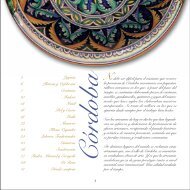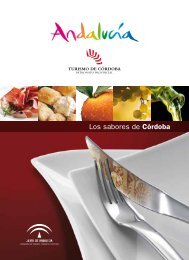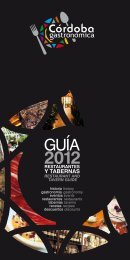Create successful ePaper yourself
Turn your PDF publications into a flip-book with our unique Google optimized e-Paper software.
Saborea Córdoba<br />
Tasting Cordoba<br />
Pocos placeres existen que superen la satisfacción obtenida tras una buena comida, y esto es algo fácil de conseguir en cualquier<br />
bar, restaurante o taberna de Córdoba. Tanto es así, que se podría decir que la ciudad Córdoba cordobesa es hoy en día la capital<br />
gastronómica andaluza, ya que a su dilatada tradición culinaria, en la que es posible seguir las trazas romanas, árabes y judías,<br />
se suma la incorporación de criterios innovadores de la cocina creativa y de autor.<br />
La cocina cordobesa refleja en sus platos, ingredientes<br />
y modo de elaboración, las tradiciones y sabores de todos<br />
los pueblos que han convivido en esta tierra. A los<br />
romanos se les debe la devoción por el aceite de oliva,<br />
base de la dieta Mediterránea, y que en las fronteras<br />
provinciales encuentra cuatro denominaciones de<br />
origen, las de Baena y Priego de Córdoba, Montoro-<br />
Adamuz y Lucena; la influencia árabe se deja notar en<br />
el gusto por la mezcla de sabores agridulces y en el uso<br />
de verduras y frutos secos, especialmente en la repostería,<br />
donde también hallamos la herencia judía.<br />
Los cristianos incorporaron la carne a la mesa cordobesa,<br />
así como las formas de elaborarla, y en la actualidad,<br />
en cualquier establecimiento de la capital, podemos<br />
degustar el sabroso jamón producido en Los<br />
Pedroches y que cuenta con Denominación de Origen.<br />
Además de buenos aceites y excelentes carnes, el recetario<br />
cordobés se nutre de otros productos obtenidos<br />
Jamón ibérico<br />
en las grandes despensas de la Sierra y la Campiña.<br />
Así legumbres, carnes de caza y el pescado, procedente indistintamente del Atlántico o del Mediterráneo, conforman su universo<br />
gastronómico, del que puede darse buena cuenta en sus múltiples bares, restaurantes y tabernas.<br />
Éstas últimas tienen una significación especial en Córdoba, tanto en su capital como en la provincia, por ser centros populares de<br />
reunión. Barrios antiguos como los de San Andrés, San Lorenzo y, sobre todo, Santa Marina, aglutinan el mayor número de estos<br />
establecimientos, donde la tertulia entre los vecinos se alterna con la degustación de platos típicos como el salmorejo, flamenquín<br />
o rabo de toro, mientras se acompañan de excelentes vinos de la tierra con Denominación de Origen Montilla-Moriles.<br />
Tanta es la importancia de estos caldos, de prestigio internacional, que alrededor de ellos se ha articulado una ruta que discurre<br />
por las bodegas del sur de la provincia, en las localidades de Montilla y Moriles principalmente. En este itinerario es esencial<br />
catar los cuatro tipos de vino de esta Denominación: Fino, amontillado, oloroso y Pedro Ximénez.<br />
There are few pleasures greater than the satisfaction of a fine meal, and this is something which is easy to find in Cordoba’s bars,<br />
restaurants, or taverns. So much so that we could say that with its long standing culinary tradition, where ancient Roman, Arabic,<br />
and Jewish influences are combined with more innovative and creative styles of cuisine, Cordoba has become the gastronomic<br />
capital of Andalusia.<br />
Its dishes, ingredients, flavours and cookery styles have inherited elements from all the peoples which over the centuries have<br />
passed through the area. The Romans introduced the use of olive oil, the basic ingredient of the Mediterranean diet, and within<br />
the province there are two designations of origin, those of Baena and Priego de Córdoba.<br />
The Arab influence can be felt in the taste for mixing sweet and sour flavours, and using vegetables<br />
and dried fruits, especially in confectionery, where there is also a Jewish tradition. The Christians<br />
brought meat to Cordoba’s meal tables. They also introduced different forms of cooking it and in<br />
the town’s establishments, one can sample the delicious cured ham produced in Los Pedroches<br />
which is protected by a Designation of Origin.<br />
In addition to good oils and excellent meats, Cordoba’s recipe books are full of products sourced<br />
from its two main larders: the Sierra (mountains) and the Campiña (valleys).<br />
Pulses, vegetables, game, and fish, caught in both the Atlantic and the Mediterranean, are the<br />
staple ingredients of a gastronomic universe which is there to be discovered in the numerous<br />
bars, restaurants, and taverns.<br />
Taverns are one of Cordoba’s most defining elements because they are the centres of social life,<br />
and the largest number can be found in districts such as San Andrés, San Lorenzo and, especially,<br />
Santa Marina.<br />
These are places where a good conversation is combined with typical dishes such as salmorejo,<br />
flamenquín or oxtail stew, and naturally accompanied by the excellent wines of the Montilla-<br />
Moriles Denomination de Origin.<br />
Such is the importance of these internationally recognised wines that they have become the main<br />
theme of a tourist route featuring the bodegas in the south of the province, mainly those located<br />
in the towns of Montilla and Moriles. Sampling the four wines of the denomination -Fino,<br />
Amontillado, Oloroso, and Pedro Ximénezis a must for those following the itinerary.<br />
Flamenquín<br />
72







